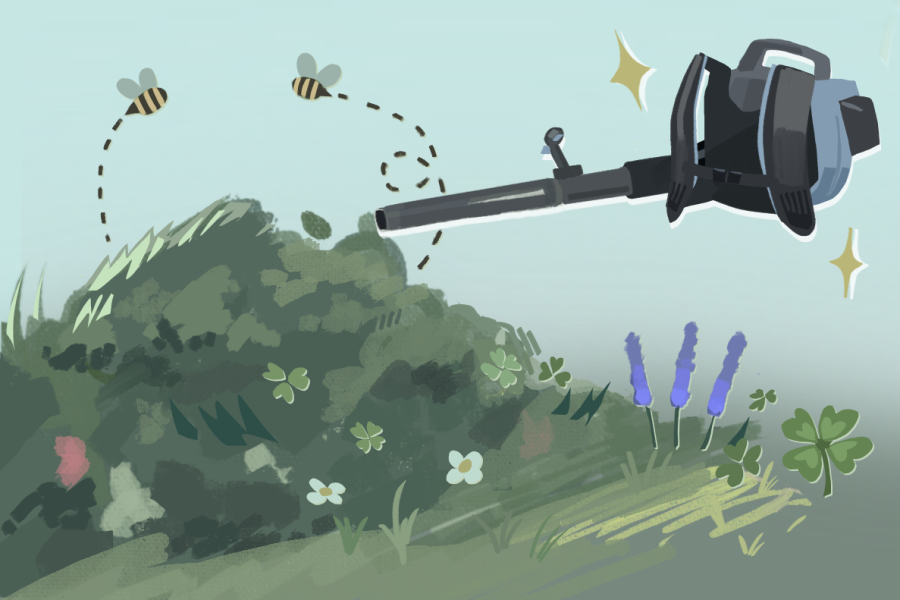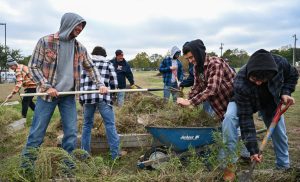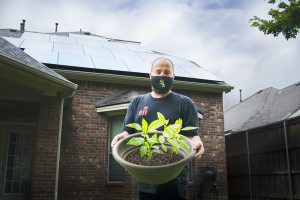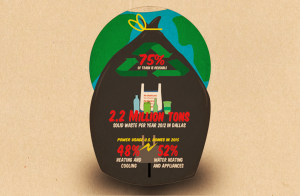Greener grass: Experts push eco-friendly lawn care
April 11, 2023
Trimmed grass isn’t an eco-friendly standard for your lawn, despite what your neighborhood homeowner’s association says. It’s a patch that’s inhospitable for organisms, plants and even nutrients in the soil.
As more people consider their carbon footprint, sustainability officials are urging homeowners on how to maintain lawns in a manner that benefits the environment.
“Eco-friendly lawn care covers a lot of different strategies and runs along a spectrum,” said Neil Kaufman, assistant director of sustainability in urban agriculture.
People can start by mowing lawns less often, Kaufman said. Letting the grass grow can breathe new life into lawns, complemented by using natural decorations such as native shrubs and minerals.
These recommendations are echoed by Dallas College’s strategies to beautify campuses while remaining sustainable.
“This included discussions of increasing the number of sculptures and native plants, but the biggest thing we have done is to make strong strides across all main locations to integrate non-soil medium,” Spradley said.
Non-soil mediums such as decomposed granite and river rock prevent weed overgrowth, simultaneously reducing the need for watering and pesticides.
In turn, eco-friendly pest management can remove invasive species without killing important organisms.
“Integrative pest management is a practice of starting with the simplest, non-chemical methods to control pests,” Kaufman said. “This reduces the risk of harming pollinators and soil microbes.”
Most industrial pesticides release runoff into local ecosystems, which spreads toxins to native organisms and social nutrients. Even nitrogen-based fertilizers can pose problems, and Kaufman recommends switching to organic solutions.
Landscapers were less available to tend campus grounds during the COVID-19 pandemic, leading to weed overgrowth. Groundskeeping crews had to adopt landscaping methods with less maintenance such as cultivating native plants.
Similar sustainable steps can be applied to the home lawn.
“For my own home, I focus on plants that are strong and hardy in the local climate, which may have a large amount of rain in a short period, and long stretches without,” Spradley said.
Several Texas flora need less irrigation compared to the water required for trimmed lawns, especially one with non-native plants.
“If you think about it, nationwide, we spend trillions of gallons of water to keep them alive,” said Christopher Morris, climate coordinator for the city of Dallas.
Over 9 billion gallons of water are used for lawn irrigation every day, according to a 2017 Environmental Protection Agency WaterSense report.
Environmental guides have published the phrase “let clover take over” as a shorthand for resilient flora overgrowth that benefits grass and soil.
“One of my personal favorites are Bearded Irises,” Spradley said. “I have several different varieties, and they are great at storing energy below ground during dry times, surviving without much water.”
Trimmed, suburban lawns tend to be monoculture, which cultivate one or few plants. Agricultural diseases thrive in these lawns.
“A healthy lawn will be green and lush,” Morris said. “It’ll have a couple of different species in there so you don’t have a monoculture.”
The effects of a trimmed and chemically cleansed lawn aren’t exclusive to your backyard.
“Conventional lawn fertilizer is very often misapplied,” Kaufman said. “Too much or just before a rain shower, the easily dissolved fertilizer will wash right into the waterway.”
Such cleaning products contain high amounts of nitrogen. When enough enters a body of water, a phenomenon called eutrophication occurs. The nitrogen concentration cultivates a toxic algae that dissolves oxygen and kills aquatic life.
“I have to work in stormwater, so when a rainstorm happens, it’s going to wash all those chemicals off your lawn and straight into the nearest stream,” Morris said.
Composting and recycling garden waste is the way to go for creating compounds that cultivate nutrients in the soil, said Kaufman.
A bountiful lawn doesn’t have to be just for beauty: Growing crops is possible, saving time and money.
Local wildlife also doesn’t have to be exposed to chemicals. Everything can be returned to the environment, and climate-aware individuals such as Spradley would rather manually pluck weeds and put them to use.
“Thankfully my lop-eared bunny, Boris, appreciates [weeds] as a snack, so I’m incentivized to do it,” Spradley said.










